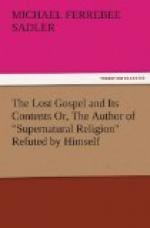“In like manner as Jesus Christ our Saviour, having been made flesh by the Word of God, had both flesh and blood for our Salvation, so likewise have we been taught that the food which is blessed by the prayer of His Word, and from which our blood and flesh are by transmutation nourished is the Flesh and Blood of that Jesus Who was made flesh.” (Apol. I. ch. lxvi.)
I trust the reader will acquit me, in making this quotation, of any desire to enunciate any Eucharistic theory of the presence of Christ’s Flesh in the Eucharist. All I have to do with is the simple fact that both Philo and St. John speak of the Word as the Bread of Life; but Philo explains that bread to be “reason,” and St. John makes our Lord to set it forth as His Flesh, and Justin takes no notice of the idea of Philo, and reproduces the idea of the fourth Gospel.
And yet we are to be told that Justin “knew nothing” of the Fourth Gospel, and that his Logos doctrine was “identical” with that of Philo.
SECTION XVIII.
DISCREPANCIES BETWEEN ST. JOHN AND THE SYNOPTICS.
The author of “Supernatural Religion” devotes a large portion of his second volume to setting forth the discrepancies, real or alleged, between the Synoptics and the Fourth Gospel.
In many of these remarks he seems to me to betray extraordinary ignorance of the mere contents of the Fourth Gospel. I shall notice two or three remarkable misconceptions; but, before doing this, I desire to call the reader’s attention to the only inference respecting the authorship of this Gospel which can be drawn from these discrepancies.
St. John’s Gospel is undoubtedly the last Gospel published; in fact, the last work of the sacred canon. The more patent, then, the differences between St. John and the Synoptics, the more difficult it is to believe that a Gospel, containing subject-matter so different from the works already accepted as giving a true account of Christ, should have been accepted by the whole Church at so comparatively recent a date, unless that Church had every reason for believing that it was the work of the last surviving Apostle.
Take, for instance, the [apparent] differences between St. John and the Synoptics respecting the scene of our Lord’s ministry, the character of His discourses, the miracles ascribed to Him, and the day of His Crucifixion, or rather of His partaking of the Paschal feast. The most ignorant and unobservant would notice these differences; and the more labour required to reconcile the statements or representations of the last Gospel with the three preceding ones, the more certain it is that none would have ventured to put forth a document containing such differences except an Apostle who, being the last surviving one, might be said to inherit the prestige and authority of the whole college.
It would far exceed the limits which I have prescribed to myself to examine the Fourth Gospel with the view of reconciling the discrepancies between it and the Synoptics, and also of bringing out the numberless undesigned coincidences between the earlier and the later account, of which the writer of “Supernatural Religion,” led away by his usual dogmatic prejudices, has taken not the smallest notice.




